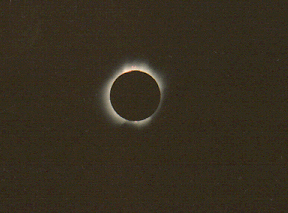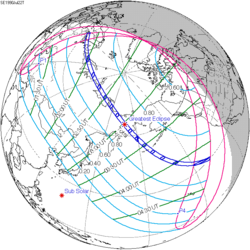| Total eclipse | |
 Totality from Playas del Coco, Costa Rica | |
| Gamma | −0.0041 |
|---|---|
| Magnitude | 1.08 |
| Maximum eclipse | |
| Duration | 413 s (6 min 53 s) |
| Coordinates | 22°00′N105°12′W / 22°N 105.2°W |
| Max. width of band | 258 km (160 mi) |
| Times (UTC) | |
| (P1) Partial begin | 16:28:46 |
| (U1) Total begin | 17:21:41 |
| Greatest eclipse | 19:07:01 |
| (U4) Total end | 20:50:28 |
| (P4) Partial end | 21:43:24 |
| References | |
| Saros | 136 (36 of 71) |
| Catalog # (SE5000) | 9489 |
A total solar eclipse occurred at the Moon's descending node of orbit on Thursday, July 11, 1991, [1] with a magnitude of 1.08. A solar eclipse occurs when the Moon passes between Earth and the Sun, thereby totally or partly obscuring the image of the Sun for a viewer on Earth. A total solar eclipse occurs when the Moon's apparent diameter is larger than the Sun's, blocking all direct sunlight, turning day into darkness. Totality occurs in a narrow path across Earth's surface, with the partial solar eclipse visible over a surrounding region thousands of kilometres wide. Occurring about 8 hours after perigee (on July 11, 1991, at 11:00 UTC), the Moon's apparent diameter was larger. [2]
Contents
- Observations
- Alleged ancient Maya prediction
- In popular culture
- Eclipse details
- Eclipse season
- Related eclipses
- Eclipses in 1991
- Metonic
- Tzolkinex
- Half-Saros
- Tritos
- Solar Saros 136
- Inex
- Triad
- Solar eclipses of 1990–1992
- Saros 136
- Metonic series
- Tritos series
- Inex series
- Notes
- References
The eclipse lasted for 6 minutes and 53.08 seconds at the point of maximum eclipse. There will not be a longer total eclipse until June 13, 2132. This was the largest total solar eclipse of Solar Saros series 136. This eclipse was the most central total eclipse in 800 years, with a gamma of −0.00412. There will not be a more central eclipse for another 800 years. Its magnitude was also greater than any eclipse since the 6th century.
Totality began over the Pacific Ocean and Hawaii, moving across Mexico, down through the Central American countries of Guatemala, El Salvador, Honduras, Nicaragua, Costa Rica and Panama, across Colombia and ending over Brazil. A partial eclipse was visible for parts of southern Canada, the United States, Mexico, Central America, the Caribbean, and South America.












































































































